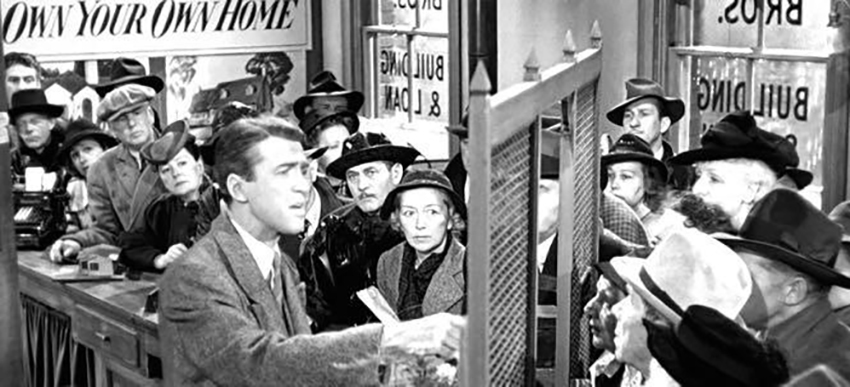by Don Gould

A still from “It’s a Wonderful Life.” Image/courtesy of Republic Pictures
In the 1946 film classic, “It’s a Wonderful Life,” community banker George Bailey (played by Jimmy Stewart) is besieged by depositors demanding their money after the despised Mr. Potter spurs a run on the bank for his own gain. George says to the anxious crowd, “No, but you … you … you’re thinking of this place all wrong! As if I had the money back in a safe. The money’s not here.” True that.
The past eight weeks have seen a series of Jimmy Stewart moments. First, Silvergate Bank of La Jolla wound itself down on March 8 after massive withdrawals triggered by cryptocurrency woes. Later that week, Silicon Valley Bank was seized by the FDIC after its depositors — mostly businesses funded by venture capital — withdrew tens of billions of dollars in a single day. New York-based Signature Bank quickly followed. And this past weekend, San Francisco’s venerable First Republic Bank was seized and sold after suffering a $100 billion deposit exodus.
Technology abets bank runs
Unlike 1946, today depositors can tweet (and terrify) one another in seconds, and can withdraw billions with mouse clicks. There’s no George Bailey to plead for cooler heads to prevail. When Silicon Valley Bank announced a stock sale to shore up its capital, a bank run ensued the next day. With 98% of its deposits uninsured, SVB’s needing capital was reason enough to move cash to a safer harbor.
Why all these bank failures now? Observers will rightly point to poor decisions by bank management, weak oversight by bank regulators, and the recent spike in interest rates. But in fact, the seeds of this bank contagion were planted with a government policy put in place way back in 2011. Absent the policy, these failed banks might still be in business. Instead, only the timing of the turmoil was in question.
The FDIC and unintended consequences
Through the FDIC, the U.S. government guarantees the first $250,000 for each depositor in each bank, should a bank fail. Deposits exceeding the limit (currently $7 trillion in total) are not insured.
After the great financial crisis of 2008-09, when even the largest banks teetered, in 2011 the U.S. designated eight giant banks (Chase, Bank of America, etc.) as “systemically important,” meaning they are too big to fail. Their deposits are effectively fully insured, regardless of amount. The ugly corollary is that America’s 4,000+ non-systemically important banks are not too big to fail, putting each at some risk of a Jimmy Stewart moment.
Midsized regional banks whose stock is publicly traded are most at risk. That’s because of the self-reinforcing relationship between the stock price and depositor behavior. A few unkind whispers about a bank can cause its stock price to dive, in turn causing depositors to flee. Where there’s smoke, there’s fire, right? The rumors quickly morph into a headline — Bank run underway.
A bank run, especially at a non-systemically important bank, feeds on itself because no one wants to be left holding uninsured deposits, knowing that the bank’s assets likely won’t cover what’s owed. Compounding the problem, regulators are maddeningly vague about whether they will bail out uninsured depositors. Case in point: Silicon Valley Bank was designated a systemically important bank, saving uninsured depositors, but only after regulators shut it down.
Fixing a broken system
To avoid these periodic spasms of bank failures, the government needs to change the rules on deposit insurance. Here are two ideas:
The FDIC could prohibit non-systemically important banks from accepting uninsured deposits. While preventing bank runs, this policy would also tilt the playing field even more in favor of the big systemically important banks and possibly stunt midsize bank lending to smaller businesses.
Or, the FDIC could insure all bank deposits, regardless of size. The argument against this is “moral hazard” — that people will then deposit money into banks without regard to how responsibly the bank uses those funds. (The 1980s savings and loan crisis is the textbook example of this.) Countering this are the plain facts of the recent bank failures — even supposedly sophisticated depositors knew next to nothing about their bank’s condition. After baseball, moral hazard is the national pastime.
Protecting your cash in the meantime
If you or your business are fortunate enough to have more than $250,000 in cash, make sure you are not over the FDIC limit in any one bank. Avoid the systemically important banks — they pay pitifully low interest rates. Instead, spread money across multiple banks and stay under the FDIC limit per bank. There are even programs (Flourish Cash, MaxMyInterest, etc.) that do this for you instantly, with each program bank paying competitive interest rates. Or you can simply buy a U.S. Treasury money market fund and get a better yield still.
In the end, Bailey Bros. Building & Loan survived. It was a simpler time.
Don Gould is president and chief investment officer of Gould Asset Management.

